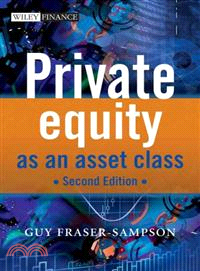Private Equity As An Asset Class 2E
商品資訊
系列名:Wiley Finance
ISBN13:9780470661383
出版社:John Wiley & Sons Inc
作者:Fraser-Sampson
出版日:2010/04/09
裝訂/頁數:精裝/280頁
規格:25.4cm*17.1cm*2.5cm (高/寬/厚)
版次:2
商品簡介
作者簡介
目次
相關商品
商品簡介
Unfairly reviled, and much misunderstood, private equity differs from all other asset classes in various important respects, not least the way in which its fund mechanisms operate, and the way in which its returns are recorded and analysed. Sadly, high level asset allocation decisions are frequently made on the basis of prejudice and misinformation, rather than a proper appreciation of the facts.
Guy Fraser-Sampson draws upon more than twenty years of experience of the private equity industry to provide a practical guide to mastering the intricacies of this highly specialist asset class. Aimed equally at investors, professionals and business school students, it starts with such fundamental questions as ’what is private equity?’ and progresses to detailed consideration of different types of private equity activity such as venture capital and buyout.
Rapid and significant changes in the environment during the recent financial crisis have prompted the need for a new edition. Separate chapters have been added on growth and development capital, as well as secondary investing. Newly emergent issues are considered, such as lengthening holding periods and the possible threat of declining returns. Particular problems, such as the need to distinguish between private equity and hedge funds, are addressed. The glossary has also been expanded. In short, readers will find that this new edition takes their understanding of the asset class to new heights.
Key points include:
A glossary of private equity terms
Venture capital
Buyout
Growth capital
Development capital
Secondary investing
Understanding private equity returns
Analysing funds and returns
How to plan a fund investment programme
Detailed discussion of industry performance figures
Guy Fraser-Sampson draws upon more than twenty years of experience of the private equity industry to provide a practical guide to mastering the intricacies of this highly specialist asset class. Aimed equally at investors, professionals and business school students, it starts with such fundamental questions as ’what is private equity?’ and progresses to detailed consideration of different types of private equity activity such as venture capital and buyout.
Rapid and significant changes in the environment during the recent financial crisis have prompted the need for a new edition. Separate chapters have been added on growth and development capital, as well as secondary investing. Newly emergent issues are considered, such as lengthening holding periods and the possible threat of declining returns. Particular problems, such as the need to distinguish between private equity and hedge funds, are addressed. The glossary has also been expanded. In short, readers will find that this new edition takes their understanding of the asset class to new heights.
Key points include:
A glossary of private equity terms
Venture capital
Buyout
Growth capital
Development capital
Secondary investing
Understanding private equity returns
Analysing funds and returns
How to plan a fund investment programme
Detailed discussion of industry performance figures
作者簡介
GUY FRASER-SAMPSON has over twenty years' experience of the private equity industry, most notably having set up and run for several years the European operations of Horsley Bridge. As a partner in the firm, and Managing Director of Horsley Bridge International, he had a unique opportunity to interact simultaneously with private equity managers from all over the world, including famous ‘golden circle’ venture firms based predominantly in California. He previously lived and worked in the Middle East as Investment Controller with the Abu Dhabi Investment Authority (ADIA).
He has extensive experience of the evaluation of private equity managers, including having personally designed and developed a computer model for the evaluation of buyout performance, but is equally recognised as an expert on venture capital. In addition to his work with funds, he has also conducted direct, secondary and mezzanine transactions over the years.
Guy teaches post-graduate modules on private equity and investment strategy at Cass Business School in the City of London, and is also recognised as an authority on all types of alternative assets. He performs consultancy and high level executive training assignments for clients around the world, and is also in demand as a provider of keynote addresses at investment conferences. In addition to various professional qualifications, he holds an LLB with honours from King's College London, and an MBA majoring in finance from Warwick Business School.
Guy writes for a number of finance and investment publications, including his influential monthly column in Real Deals. He is the author of Multi-Asset Class Investment Strategy, also published as part of the Wiley Finance series, which questions accepted views of risk and return, and sets out ways in which investors could and should incorporate a wide range of so-called alternative assets into their planned portfolios. He conducts regular investor workshops around the world based upon his books.
He has extensive experience of the evaluation of private equity managers, including having personally designed and developed a computer model for the evaluation of buyout performance, but is equally recognised as an expert on venture capital. In addition to his work with funds, he has also conducted direct, secondary and mezzanine transactions over the years.
Guy teaches post-graduate modules on private equity and investment strategy at Cass Business School in the City of London, and is also recognised as an authority on all types of alternative assets. He performs consultancy and high level executive training assignments for clients around the world, and is also in demand as a provider of keynote addresses at investment conferences. In addition to various professional qualifications, he holds an LLB with honours from King's College London, and an MBA majoring in finance from Warwick Business School.
Guy writes for a number of finance and investment publications, including his influential monthly column in Real Deals. He is the author of Multi-Asset Class Investment Strategy, also published as part of the Wiley Finance series, which questions accepted views of risk and return, and sets out ways in which investors could and should incorporate a wide range of so-called alternative assets into their planned portfolios. He conducts regular investor workshops around the world based upon his books.
目次
About the Author.
Acknowledgements.
Introduction.
1 What is Private Equity?
What is Private Equity?
Fund investing versus direct investing.
Co-investment.
Terminology.
Different types of Private Equity investment.
Summary.
2. What are Private Equity Funds, and How do They Work?
Capital: Allocated, Committed, Drawn Down and Invested.
How do Private Equity Funds Work?
Structure.
Cash flow.
Investment.
Fundraising.
Private Equity Funds Distinguished from Other Fund Types.
Hedge funds.
Infrastructure.
Private (Equity) Real Estate.
A Note on International Issues.
Summary.
3. Private Equity Returns – The Basics.
Understanding the J-curve and Compound Returns.
Upper Quartile Figures.
Median Returns.
Average Returns.
Pooled Returns.
Using Vintage Year Returns for Benchmarking Purposes.
Time-weighted Returns.
Summary.
4 Private Equity Returns – Multiples and Muddles.
Multiples.
Distributed over paid in (DPI).
Paid in to committed capital (PICC).
Residual value to paid in (RVPI).
Total value to paid in (TVPI).
Use of multiples in industry research.
Muddles, Muggles and Markowitz.
Returns.
Risk.
Liquidity.
Summary.
5 Buyout.
Types of Buyout Transaction.
MBO.
MBI.
BIMBO.
LBO.
Take Private (P2P).
Roll-up.
Secondary Buyouts.
Other 'Buyout' Activity.
PIPEs.
How do Buyouts Work?
Characteristics of Buyout.
Established businesses.
Debt.
Earnings.
Size.
Control.
Barriers to entry.
Summary.
6 How to Analyse Buyouts.
Earnings.
EBIT.
EBITDA.
Earnings Growth.
Multiple.
Multiple increase (sometimes called multiple arbitrage).
Leverage.
Recapitalisation.
Timing.
Modelling and Analysing Buyout Funds.
Enterprise value.
Summary.
7 Buyout Returns.
US versus European Buyout.
Buyout skill bases.
Imperfect markets.
Earnings multiples.
Earnings growth.
Leverage.
Contribution of different drivers.
Fund size.
Summary.
8 Venture Capital.
What is Venture Capital?
Backing New Applications, Not New Technology.
Classifi cation by Sector.
IT.
Telecoms.
Life Science.
Classifi cation by Stage.
Seed stage.
Early stage.
Mid and late stages.
Summary.
9 How to Analyse Venture.
The Fundamentals (1) – Money Multiples.
The Fundamentals (2) – Valuation.
Valuation as an element of stated returns.
Differences in valuation approach between Europe and the US.
Variability of Venture valuations.
Pre-money and post-money valuations.
Share classes.
The Fundamentals (3) – Cost and Value.
IRRs and multiples.
Going in equity (GI%).
Percentage of the holding within the fund.
The Impact of Home Runs.
Summary.
10 Venture Returns.
US Outperformance versus Europe.
Money multiples drive IRRs.
Home runs and the golden circle.
Market conditions.
European Venture – Is it as Bad as it Seems?
Returns and Fund Size.
Venture returns by stage.
What of the Future?
Summary.
11. Growth and Development Capital.
The PLC and the BCG Growth Matrix.
Development Capital.
Target companies.
Money in deals.
Money out deals.
Objectives.
Growth Capital.
Target companies.
Objectives.
Growth capital and late-stage Venture.
Common Issues.
Minority protection.
Exit protection.
The Future.
Summary.
12. Secondary Private Equity Fund Investing.
Why do People Buy Secondaries?
Time and the J-curve.
Diversifi cation by time.
Diversifi cation by geography and sector.
Treasury and Portfolio Secondaries.
Why do People Sell Secondaries?
Change of strategy/leaving the asset class.
Overconcentration by time, sector or geography.
Unexpected need for cash.
Housekeeping.
Dissatisfaction with the GP.
Restrictions on Transfer.
Stapled primaries.
Secondary Methodology.
Tails.
Fees etc.
Secondary Buyouts - Warning.
Summary.
13. Due Diligence.
Buyout Funds.
Venture Funds.
Co-investors.
Cross-fund Investing.
Buyout Companies.
Venture Companies.
Funds of Funds.
Growth and Development Capital.
Monitoring Private Equity Funds.
The Changing Nature of Due Diligence.
Summary.
14. Planning Your Investment Programme.
Cash Flow Planning.
Allocated, Committed and Invested Capital.
Diversifi cation by Time.
Proper Commitment Levels.
Diversifi cation by Sector and Geography.
Total Return.
How to deal with uninvested capital.
Towards a New World of Private Equity Programmes?
Summary.
15. Trends and Issues.
Financial Crisis.
Credit.
Valuation.
Holding periods.
Secondaries.
Emerging Markets.
Concluding Thoughts.
Track record.
Returns.
Fee structures.
Private Equity at a Crossroads?
Summary.
Glossary of Private Equity Terms.
Index.
Acknowledgements.
Introduction.
1 What is Private Equity?
What is Private Equity?
Fund investing versus direct investing.
Co-investment.
Terminology.
Different types of Private Equity investment.
Summary.
2. What are Private Equity Funds, and How do They Work?
Capital: Allocated, Committed, Drawn Down and Invested.
How do Private Equity Funds Work?
Structure.
Cash flow.
Investment.
Fundraising.
Private Equity Funds Distinguished from Other Fund Types.
Hedge funds.
Infrastructure.
Private (Equity) Real Estate.
A Note on International Issues.
Summary.
3. Private Equity Returns – The Basics.
Understanding the J-curve and Compound Returns.
Upper Quartile Figures.
Median Returns.
Average Returns.
Pooled Returns.
Using Vintage Year Returns for Benchmarking Purposes.
Time-weighted Returns.
Summary.
4 Private Equity Returns – Multiples and Muddles.
Multiples.
Distributed over paid in (DPI).
Paid in to committed capital (PICC).
Residual value to paid in (RVPI).
Total value to paid in (TVPI).
Use of multiples in industry research.
Muddles, Muggles and Markowitz.
Returns.
Risk.
Liquidity.
Summary.
5 Buyout.
Types of Buyout Transaction.
MBO.
MBI.
BIMBO.
LBO.
Take Private (P2P).
Roll-up.
Secondary Buyouts.
Other 'Buyout' Activity.
PIPEs.
How do Buyouts Work?
Characteristics of Buyout.
Established businesses.
Debt.
Earnings.
Size.
Control.
Barriers to entry.
Summary.
6 How to Analyse Buyouts.
Earnings.
EBIT.
EBITDA.
Earnings Growth.
Multiple.
Multiple increase (sometimes called multiple arbitrage).
Leverage.
Recapitalisation.
Timing.
Modelling and Analysing Buyout Funds.
Enterprise value.
Summary.
7 Buyout Returns.
US versus European Buyout.
Buyout skill bases.
Imperfect markets.
Earnings multiples.
Earnings growth.
Leverage.
Contribution of different drivers.
Fund size.
Summary.
8 Venture Capital.
What is Venture Capital?
Backing New Applications, Not New Technology.
Classifi cation by Sector.
IT.
Telecoms.
Life Science.
Classifi cation by Stage.
Seed stage.
Early stage.
Mid and late stages.
Summary.
9 How to Analyse Venture.
The Fundamentals (1) – Money Multiples.
The Fundamentals (2) – Valuation.
Valuation as an element of stated returns.
Differences in valuation approach between Europe and the US.
Variability of Venture valuations.
Pre-money and post-money valuations.
Share classes.
The Fundamentals (3) – Cost and Value.
IRRs and multiples.
Going in equity (GI%).
Percentage of the holding within the fund.
The Impact of Home Runs.
Summary.
10 Venture Returns.
US Outperformance versus Europe.
Money multiples drive IRRs.
Home runs and the golden circle.
Market conditions.
European Venture – Is it as Bad as it Seems?
Returns and Fund Size.
Venture returns by stage.
What of the Future?
Summary.
11. Growth and Development Capital.
The PLC and the BCG Growth Matrix.
Development Capital.
Target companies.
Money in deals.
Money out deals.
Objectives.
Growth Capital.
Target companies.
Objectives.
Growth capital and late-stage Venture.
Common Issues.
Minority protection.
Exit protection.
The Future.
Summary.
12. Secondary Private Equity Fund Investing.
Why do People Buy Secondaries?
Time and the J-curve.
Diversifi cation by time.
Diversifi cation by geography and sector.
Treasury and Portfolio Secondaries.
Why do People Sell Secondaries?
Change of strategy/leaving the asset class.
Overconcentration by time, sector or geography.
Unexpected need for cash.
Housekeeping.
Dissatisfaction with the GP.
Restrictions on Transfer.
Stapled primaries.
Secondary Methodology.
Tails.
Fees etc.
Secondary Buyouts - Warning.
Summary.
13. Due Diligence.
Buyout Funds.
Venture Funds.
Co-investors.
Cross-fund Investing.
Buyout Companies.
Venture Companies.
Funds of Funds.
Growth and Development Capital.
Monitoring Private Equity Funds.
The Changing Nature of Due Diligence.
Summary.
14. Planning Your Investment Programme.
Cash Flow Planning.
Allocated, Committed and Invested Capital.
Diversifi cation by Time.
Proper Commitment Levels.
Diversifi cation by Sector and Geography.
Total Return.
How to deal with uninvested capital.
Towards a New World of Private Equity Programmes?
Summary.
15. Trends and Issues.
Financial Crisis.
Credit.
Valuation.
Holding periods.
Secondaries.
Emerging Markets.
Concluding Thoughts.
Track record.
Returns.
Fee structures.
Private Equity at a Crossroads?
Summary.
Glossary of Private Equity Terms.
Index.
主題書展
更多
主題書展
更多書展今日66折
您曾經瀏覽過的商品
購物須知
外文書商品之書封,為出版社提供之樣本。實際出貨商品,以出版社所提供之現有版本為主。部份書籍,因出版社供應狀況特殊,匯率將依實際狀況做調整。
無庫存之商品,在您完成訂單程序之後,將以空運的方式為你下單調貨。為了縮短等待的時間,建議您將外文書與其他商品分開下單,以獲得最快的取貨速度,平均調貨時間為1~2個月。
為了保護您的權益,「三民網路書店」提供會員七日商品鑑賞期(收到商品為起始日)。
若要辦理退貨,請在商品鑑賞期內寄回,且商品必須是全新狀態與完整包裝(商品、附件、發票、隨貨贈品等)否則恕不接受退貨。
























